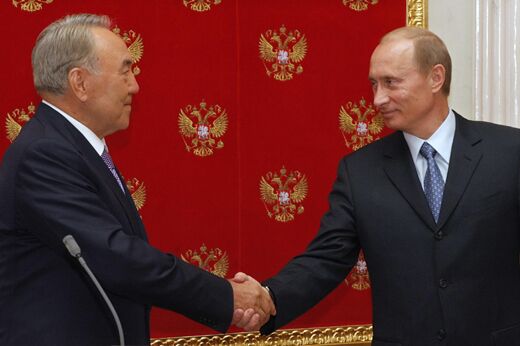
Europe Seeks Control of Central Asian Energy
“The time is right for a new, closer cooperation.” German Foreign Minister Frank-Walter Steinmeier, visiting Astana, Kazakhstan, on March 28, was speaking of Europe’s ambitious drive to build energy relations in Central Asia. “The EU aims to diversify its energy policy. This is why it is necessary to increase our contacts with Central Asia,” Steinmeier stated.
It is clearly Europe’s, and particularly Germany’s, goal to make Central Asia a major energy source for the European Union. The trouble is, Central Asia is traditionally an area of Russian interest and domination.
European delegates met with Azerbaijani, Georgian and Kazakh officials on April 2 to discuss planning and financing of a TransCaspian gas pipeline. Natik Aliyev, Azerbaijan’s industry and energy minister, said his country is ready to cooperate with European desires for gas transportation and an EU energy corridor in Central Asia.
Coincident with this event, five southeastern European countries signed a joint declaration to build a pipeline to transport Caspian oil from the Black Sea to Western Europe. The 870-mile-long Pan-European Oil Pipeline, scheduled for completion in 2012, will run from the Romanian port of Constanta to Trieste, Italy.
The Baku-Tbilisi-Ceyhan (btc) pipeline, sponsored by Europe’s Organization for Security and Cooperation in Europe, served as Europe’s first success in building energy partnerships within Central Asia and the Caucasus. Conceived in the late 1990s, the btc pipeline runs from the Azerbaijani Caspian Sea coast through Georgia to Turkey’s Mediterranean Sea port of Ceyhan and has an estimated shipping capacity of 1 million barrels per day. From there, Central Asian energy can be transported to Europe. Kazakhstan recently broke ranks with Russian leadership—of which it has traditionally been a staunch supporter—when it committed to supply the btc pipeline with 733 million barrels of Kazakhi oil in a barge route agreement with Azerbaijan.
Europe’s plans for Central Asia include spending $930 million on projects in the region. Signalling their intent to ratchet up the competition over the area, EU leaders are expected to adopt a formal Central Asia strategy at a summit in June. Should everything proceed as planned, up to 200 European diplomats could fill new embassies in the region by 2008.
All of these efforts in Central Asia underscore the Continent’s growing unease over its dependence on Russian energy. By most accounts, Russia is viewed as an unreliable partner for Europe. Currently, Europe depends heavily on Russian energy supplies, with 25 percent of Europe’s oil imports being supplied by Russia. Additionally, the lion’s share of Central Asia’s oil and gas pipelines feed into Russia’s energy transport system. Russia, in this enviable position, buys Central Asian gas at deep discounts, oftentimes under $100 per cubic meter, while selling it for $230 per cubic meter to European customers.
The reality of Europe’s energy dependence on foreign sources, plus the allure of cheaper energy than what Russia presently supplies, have driven Europe to develop closer energy cooperation with Central Asia and the Caucasus.
For their part though, both Russia and China are determined to limit Europe’s influence in Central Asia.
Together, Russia and China have built an impressive framework of political, military and economic cooperation between themselves and Central Asian states: the Russian-led Collective Security Treaty Organization, built to prevent Central Asian states from aligning with nato; Russia’s Commonwealth of Independent States, a Russian platform to coordinate Central Asia policy with Central Asian states; China’s Shanghai Cooperation Council, a political tool to coordinate collective security policy toward Chinese and somewhat Russian interests; and casfor, a proposed Caspian Sea naval taskforce Russia has advocated since 2005. Observers suggest that the Russian-led casfor plan is a guise for assuming control of the energy-rich Caspian Sea and that Russia plans to guard coastal installations and obstruct Western influence over Caspian Sea energy development.
In fact, Russia’s ongoing economic success and revival as a world power hinge in part on its dominance of Central Asia. Pipelines and gas from Central Asia help to undergird a robust economy growing at 6 percent a year. Ramped-up military spending, a busy construction industry, and a budding economy define the new imperial Russia awash in energy profits. In 2007 alone, Russia plans to spend $31 billion on its military—four times what it was spending just five years ago.
Europe’s aggressive Central Asian policy and Caucasus energy corridor may see a reaction from Russia. Already, Russia has objected to Central Asian cooperation with America and Europe. Sergei Ivanov, Russia’s defense minister, stated, “The countries of the region are members of the Collective Security Treaty Organization. And [if these countries are] making a decision about hosting new bases on their territory, they should take into account the interests of Russia and coordinate this decision with our country” (Stephen J. Blank, U.S. Interests in Central Asia and the Challenges to Them).
By pushing into territory Russia has historically dominated, Europe risks aggravating relations with its main energy supplier. It may embolden Russia to take further steps to consolidate its power in the region. Watch for increasing tensions between the European Union and Russia over Central Asian energy.
